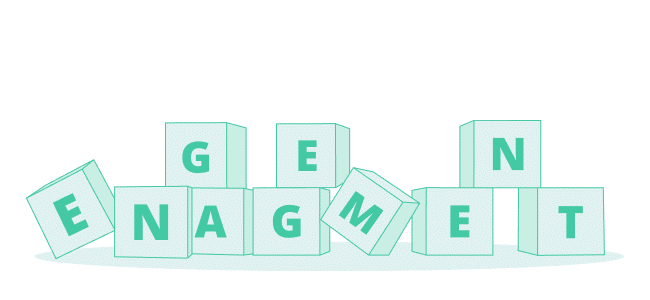Having an effective engagement platform implemented to maintain and increase the entire working environment and employee well-being is an extremely important decision. But if you have to go all out and ring the big, solid well-being bell, then you should consider getting a certified working environment advisor on board in the process.
Which question frame should be used?
Well, it probably goes without saying that the question frame is crucial for your engagement measurements. The questions MUST reflect the company’s framework and be decidedly industry-specific. Otherwise, you might get an answer in the West, even if you ask in the East – and that doesn’t add much value in the end. So, it is a good idea to get expert guidance from someone who has carried out a lot of well-being surveys and who has knowledge of the various industries and from there can put together the right questionnaire for the company.
A small side note here is that Woba.io actually offers (as one of the few providers) the possibility to design a completely specific and self-selected question frame for the individual measurement – and in this way it is ensured that the frames are not standardized, but on the contrary tailored for both industry, employees and company.
What should be looked for?
When you’re not trained in this field, you most likely won’t know exactly what to look for in the results either. A certified work environment adviser is trained to look in exactly the right places – and to discover the things that stick out a little and which, over time, can create problems for well-being and job satisfaction. And the great value in driving with regular measurements is precisely that you get the opportunity to be at the forefront and be able to deal with problems at such an early stage that dismissals and sick leave are completely avoided. Your occupational health and safety adviser will help you with this.
From onboarding to impact measurement
The process with your Customer Success Manager and Working Environment Adviser in Woba.io can be seen as a form of cycle. A very important cycle. The moment you choose to become a customer of Woba.io, you enter our specific and very important Employee Retention Life Cycle.
- step – Onboarding
- step – Survey is carried out
- step – The results are analyzed and presented
- step – Action plans
- step – Effect measurement and follow-up

And why now all that?
The whole thinking in Woba.io is to implement a preventive, proactive approach to the entire well-being work – instead of the hitherto reactive approach that has characterized the entire HR thinking, where you have worked ‘in the background’ all the time – and in that way is always 3-6 months behind in relation to employee well-being. In a time when more than 40% of all employees are currently considering resigning, it is a definite necessity that companies make a big effort to meet the well-being problems at an early stage.
The most effective way you can do this is with a digital, dynamic solution, where the important well-being measurements can be easily and intuitively carried out – and where the results are continuously available, so that the necessary action measures can be implemented and the specific challenges remedied.
The dynamic, digital approach opens up the preventive way of working with engagement. And it creates a shift in relation to the past way of thinking about HR.
In addition, something else also happens. In the past, HR has been very individual-focused. When an employee via a Health and Safety Assessment or an engagement survey has shown symptoms of burnout, then they have worked on it from the individual level, which means therapy, coaching and other things that focus on the individual employee who is affected. But with this new approach, it is not only possible to work preventively. You also get the opportunity to intervene at an early stage – all the way through the organisation.
In Woba.io, for example, we work with action initiatives that are research-based and are all linked to the IGLO model. IGLO stands for Individual, Group, Management and Organization level. When an employee is affected by stress, it is not just an isolated problem for the employee. It is an expression of the fact that there are some significant problems all around the organisation. And the well-being work must also be carried out at all organizational levels – if it is to be effective and actually create an improvement in the working environment so that your employees thrive.
A cycle of meaning
Onboarding consists of an initial meeting with your associated Customer Success Manager. Here you agree expectations and the process itself is mapped out so that both parties know the details of the collaboration. It is quite simple and clear to get started, because it is your Customer Success Manager who does all the work, so to speak. You just need to ensure that you provide access to the employees’ data and email addresses, and we will take care of the actual implementation in the Woba.io platform. And as soon as the implementation is in place, the first measurement can be planned.
Woba.io has been created in a very intuitive design, which makes it easy and clear for all employees – across all industries – to participate and not least to follow up on their own results. When the measurement has been completed, all results must be analyzed thoroughly, so that we are sure that it is the most important problems and areas for improvement that come to light – and which are focused on and dealt with. Your Customer Success Manager also takes care of that – and he/she will collect all the results in a comprehensive and detailed report and of course follow up with a live presentation of the whole thing. But it doesn’t stop there…
Because measurement and its results are one thing. It is actually the follow-up work that is essential for the company’s future well-being.
Action plans must now be drawn up and they must be as specific, concrete and detailed as possible. After all, the well-being of the entire company depends on these action plans and their execution. After implementation of action plans and action measures, a so-called impact measurement will always be run. This is normally 3-6 months after the original measurement. And the impact measurement is your guide to see if the implemented action measures are correct or if everything needs to be adjusted and optimized. It also helps your Customer Success Manager to analyze.
But what does it mean in practice when I have chosen Woba.io?
You can say that your associated Customer Success Manager takes you a long way in relation to the engagement work. But if you want to make sure that there is always a certified working environment adviser ready to hold your hand and guide you on the right path to well-being, then you should choose Woba.io, which always includes concrete working environment advice. You might liken working environment advice to an easily accessible support function. And it can certainly be quite ‘handy’ when you have a question or are really in doubt about the daily well-being work.
Your certified working environment advisor also has insight into all statutory measures and will advise you so that the company’s well-being work will always be within the framework of the law and the Danish Working Environment Authority. As the only provider on the market, Woba.io offers this as implicit in the collaboration.
Your certified occupational health and safety advisers in Woba.io
At Woba.io, we believe in basic empathy and human insight as the cornerstone of our customer service. That is why we have put together a team of skilled, detail-oriented and empathetic employees in our Customer Success department.
Want to learn more about the Woba solution? >> BOOK A DEMO <<











